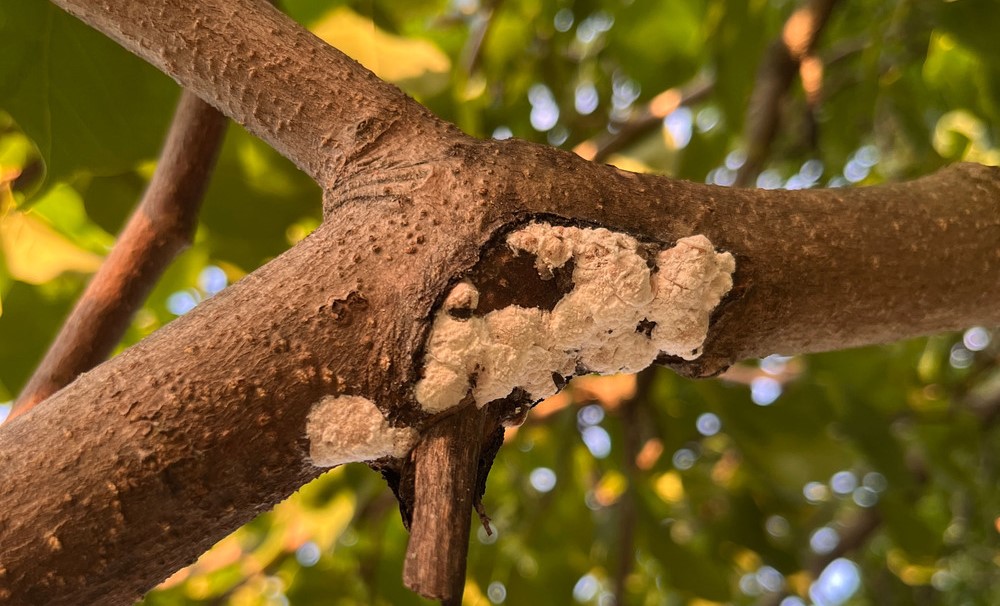What’s that white stuff on my magnolia tree? Magnolia scale

JACKSONVILLE, Ill. — Magnolias are popular trees and shrubs in many landscapes. Their large, showy flowers can range from white to pink to yellow and provide a burst of color in the spring. While they are relatively pest-free, one of the biggest pests is the magnolia scale (Neolecanium cornuparvum).
What does magnolia scale look like, and life cycle
Magnolia scale overwinters as dark-colored nymphs. As temperatures warm in the spring, the nymphs will begin feeding on plant sap, usually around the time leaves begin to emerge. They will grow quickly and will appear as oval bumps on twigs and branches and are often covered in a white, powdery, waxy substance. When female magnolia scales are mature, they can be up to ½ long. They will also lose their waxy coating and will have a helmet-shaped appearance.
Mature females will give birth to live young, called crawlers, from late summer to early fall. The crawlers are small (1/25 inch), flat, and oval. They are the only life stage that is mobile and will search for a place to feed. Once they have found a suitable site, usually newer growth, they will begin to feed and spend the rest of their lives in that spot.
Damage caused by magnolia scale
Magnolia scale will feed on the sap of plants. When populations become large, this feeding can weaken trees and, in extreme cases, kill trees. Non-native magnolia species and hybrids such as star (Magnolia stelleta), saucer (Magnolia x soulangiana), and lily (M. liliiflora) are most susceptible to magnolia scale. Native species like cucumber magnolia (M. acuminata) may be attacked but are rarely damaged, and some, like sweetbay magnolia (M. virginiana) are rarely attacked.
In addition to feeding on sap, magnolia scale will also produce large amounts of honeydew which will cover the plants and anything beneath them. A fungus known as sooty mold will grow on the honeydew and can cause objects to become unsightly.
Managing magnolia scale
If you have magnolias in your landscape, particularly non-native species or hybrids, periodically inspect your plants for the presence of magnolia scale; the sooner you notice them, the easier it is to manage them. Fortunately, there are several ways magnolia scale can be managed:
- Physically remove them. If the infestation is small, it can be removed by hand or by using a soft-bristled scrub brush. This should be done as soon as you notice the scale and before crawlers emerge. Heavily infested branches can be pruned out.
- Natural enemies: Several different kinds of insects will feed on the magnolia scale. However, they often can’t keep up when populations get large, and may not be a reliable management tool.
- Insecticides: Insecticides are the most common way to manage magnolia scale, but timing is important. The crawlers are the most susceptible stage to insecticides. Contact insecticides can be used in late summer or early fall to manage crawlers. More than one application will often be needed. Dormant oil sprays can also be used in early spring before buds begin to break. Because of their size, it may be best to have a professional treat large trees.
- Systemic insecticides can also be used in early May. These products are applied to the soil and will be taken up and moved throughout the plant.
If you choose to apply insecticides to manage magnolia scale, regardless of what you use and when you apply it, make sure to read and follow all label directions.
Good Growing Fact of the Week: Ants will often feed on honeydew produced by soft scales, like magnolia scale, and will defend them from potential predators. Research done in Kentucky found that if ants are excluded from magnolia trees there was an 82% reduction in the number of adult magnolia scales on those trees.
Miss Clipping Out Stories to Save for Later?
Click the Purchase Story button below to order a print of this story. We will print it for you on matte photo paper to keep forever.

